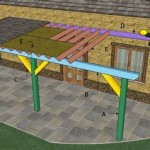How To Design A Patio: A Comprehensive Guide
Designing a patio is a process that requires careful consideration of several factors, including space, budget, desired functionality, aesthetics, and long-term maintenance. A well-designed patio can significantly enhance outdoor living, providing a space for relaxation, entertainment, and connecting with nature. This article offers a comprehensive guide to designing a patio, covering key considerations and steps to ensure a functional and visually appealing outdoor space.
Assessing Needs and Defining Purpose
The initial step in patio design involves identifying the intended use of the space. This will heavily influence the size, layout, materials, and features incorporated into the design. Considerations should include the expected number of users, types of activities to be accommodated, and desired atmosphere.
For example, a patio designed primarily for dining might require a larger area to accommodate a table and chairs, along with adequate space for circulation. Conversely, a patio intended for quiet relaxation may be smaller, with comfortable seating and features that promote tranquility, such as a water feature or lush landscaping.
Furthermore, consider the time of day the patio will be used most frequently. A patio intended for daytime use may benefit from shade structures, such as pergolas or umbrellas, to provide respite from the sun. A patio designed for evening use might incorporate lighting features to create ambiance and extend its usability.
Budget constraints are also a crucial consideration. Establishing a realistic budget early in the design process will help to prioritize features and materials, preventing overspending and ensuring the project remains financially feasible. This involves researching material costs, labor fees (if hiring professionals), and potential permit requirements.
Finally, consider the existing landscape and architectural style of the house. The patio design should complement the overall aesthetic of the property, creating a cohesive and harmonious look. This can be achieved by selecting materials that match the existing house facade, incorporating similar landscaping elements, and maintaining a consistent design theme.
Selecting Materials and Layout
The choice of materials is a critical aspect of patio design, impacting both aesthetics and functionality. Materials should be durable, weather-resistant, and appropriate for the intended use of the patio. Common patio materials include concrete, pavers, brick, natural stone, and wood.
Concrete is a versatile and cost-effective option, offering a wide range of design possibilities through staining, stamping, and texturing. Pavers are another popular choice, providing a modular system that is easy to install and maintain. Pavers are available in various shapes, sizes, colors, and materials, including concrete, brick, and natural stone.
Brick offers a classic and timeless look, adding warmth and character to the patio. It is also durable and relatively low-maintenance. Natural stone, such as flagstone or slate, provides a unique and organic feel, blending seamlessly with the surrounding landscape. However, natural stone can be more expensive than other options and may require professional installation.
Wood can be used for decking or as accents within the patio design. It provides a warm and inviting feel but requires regular maintenance to prevent rot and decay. When using wood, it is essential to choose a durable and weather-resistant variety, such as cedar or redwood.
The layout of the patio should be carefully planned to maximize space and functionality. Consider the flow of traffic, placement of furniture, and integration with the surrounding landscape. A well-designed layout will create a comfortable and inviting space that is easy to navigate. Utilize graph paper or design software to visualize different layout options before committing to a final design.
Levels and elevation changes can add visual interest and define different zones within the patio. For instance, a raised patio can create a sense of separation from the lawn or garden, while steps or ramps can provide access to different areas. Incorporating retaining walls can also create level surfaces and prevent soil erosion.
Consider the orientation of the patio in relation to the sun. A patio facing south will receive the most sunlight, while a patio facing north will be shaded. Designing with the sun's path in mind can help create a comfortable and usable outdoor space year-round. Incorporating shade structures and landscaping can further mitigate the effects of the sun.
Incorporating Features and Enhancements
The addition of features and enhancements can significantly enhance the functionality and aesthetics of a patio. These features can include seating, lighting, heating, cooking facilities, water features, and landscaping.
Seating is a fundamental element of any patio design. Choose furniture that is comfortable, durable, and appropriate for the intended use of the patio. Options include lounge chairs, dining sets, benches, and built-in seating. Consider the style of the furniture and how it complements the overall design of the patio.
Lighting is essential for extending the usability of the patio into the evening. Incorporate a variety of lighting options, including ambient lighting, task lighting, and accent lighting. Ambient lighting provides general illumination, while task lighting is focused on specific areas, such as a dining table or grilling area. Accent lighting highlights specific features, such as plants or water features.
Heating elements, such as fire pits or outdoor heaters, can extend the use of the patio into cooler months. Fire pits offer a focal point for gathering and socializing, while outdoor heaters provide targeted warmth. Consider the size and location of the heating element, ensuring it is safe and appropriate for the space.
Outdoor kitchens and cooking facilities can transform a patio into an entertainment hub. Options range from simple grills to elaborate outdoor kitchens with countertops, sinks, and storage. Consider the frequency of use and the types of food to be prepared when designing the cooking area.
Water features, such as fountains or ponds, can add a soothing and tranquil element to the patio. The sound of flowing water can mask unwanted noise and create a relaxing atmosphere. Consider the size and maintenance requirements of the water feature when incorporating it into the design.
Landscaping plays a crucial role in creating a visually appealing and inviting patio. Incorporate a variety of plants, trees, and shrubs to add color, texture, and privacy. Consider the climate and growing conditions when selecting plants, choosing species that are well-suited to the local environment. Container gardening is an excellent option for patios, allowing for flexibility and easy maintenance.
Furthermore, consider adding privacy screens or hedges to create a more secluded and intimate space. Privacy screens can be constructed from various materials, including wood, metal, or bamboo. Hedges can provide a natural and aesthetically pleasing privacy solution. The choice will depend on desired level of privacy, budget, and aesthetic preferences.
Finally, consider the long-term maintenance requirements of the patio. Choose materials and features that are easy to clean and maintain. Regular cleaning and maintenance will help to keep the patio looking its best for years to come.
By carefully considering these factors and planning the design meticulously, it is possible to create a patio that meets the needs and preferences of the homeowner, providing a valuable outdoor living space for relaxation, entertainment, and enjoyment.

50 Patio Ideas For The Backyard Of Your Dreams
:strip_icc()/101690540-c5dc68495b6c4b29845ae8bc2b79fead.jpg?strip=all)
Step By Patio Design Plans For An Outdoor Space You Ll Love

House Home 7 Patio Design Tips From The Pros

Patio Design Ideas Garden Gate

How To Design And Build Your Own Patio

9 Small Patio Designs With Big Impact Romanstone Hardscapes

How To Design A Patio Expert Advice On Homes Gardens

Patio Design Tips

Patio Design And Installation 101 Outdoor Living Blog Southview

Patio Paver Design Tips Ideas
See Also








